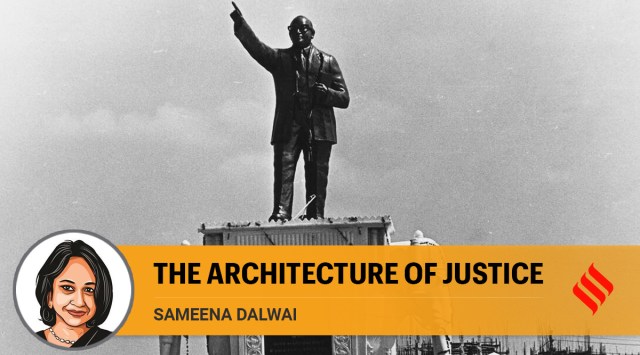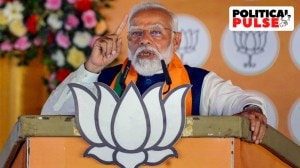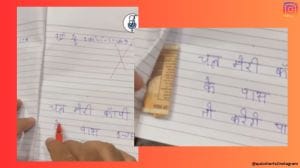- India
- International
Why statues, parks celebrating Dalit icons matter
🔴 Sameena Dalwai writes: They are a way for the marginalised to claim their rightful share of public space and history
 Ambedkar Park in Lucknow. (Express photo by Ravi Batra)
Ambedkar Park in Lucknow. (Express photo by Ravi Batra)Before I visited the Ambedkar Park in Lucknow, all the criticism I had heard over the years echoed in my ears: “What an obscene display of idols and elephants”, “Utter waste of money and space — could have opened a hospital instead”, “Everywhere Mayawati statues with her purse — how tacky!” A few years ago, Supreme Court judges had even observed that former CM Mayawati should pay back the public funds used to build the statues.
With all this in my head, I was prepared to be underwhelmed. But when I entered the park, I was struck by its sheer expanse and magnitude. A huge open space with many structures, a tall pillar with the Ashoka Chakra, rows of trees, an army of stone elephants. The history of social reform comes alive with statues and stories of Mahatma Jyotirao Phule, Shahu Maharaj, Kabir, Ravidas, Buddha, Birsa Munda, and, lastly, Ambedkar and Kanshi Ram — visionaries who worked against caste or gender oppression, who envisioned a radically different society. We see Phule and Savitribai teaching girls, Birsa Munda fighting the British, Kanshi Ram on a bicycle. Bahujan history, which is seldom taught in schools, is depicted here through statues and pictures.
What is history? An effort to understand where we come from, what heritage we carry. But in the “his-story” of kings and wars, we rarely get to know how the oppressed, women, peasants and artisans lived. We know about the Harappan civilisation that existed in India or the Incas in Peru from remnants of their material culture. But what do the enslaved African populations in America possess to show for their history? Branding iron, shackles, neck collars and whips — this is what the slavery museums in the UK and US display today.
In India, what can Dalits show as their history? The Brahmins have their temples, the Kshatriyas their forts, Vaishyas their bazaars, even Shudras their crafts, but Dalits? In some villages in Maharashtra, Mangira temples speak of a cruel past. It is believed that when villagers started building a new boundary wall for the village or a new well, they would sacrifice a Mang young man for good luck. A temple would be built on the site. Dalits today are inheritors of this cruel history.
Each village is ordered by a “caste geography”, with Dalits kept outside. They are not allowed into the village except for reasons of servitude; they may not wear shoes or headgear, their wedding processions may not pass through the village, they may not build cement houses or any structure above a certain height. What heritage will they claim?

In January 2018, the annual pilgrimage of Mahars to Bhima Koregaon was attacked by the right wing. It was the 200th anniversary of the battle of Bhima Koregaon, when the British won a decisive victory over the last Peshwas of Pune. Upper caste Maharashtrians bemoan it as a “defeat of Indians”, but the Peshwa rule was repressive for Dalits. Only Chitpawan Kokanastha Brahmins held top military positions, wielded financial and religious power as saukars and priests. They beggared the peasantry through exorbitant taxes and drove “untouchables” to an inhuman existence. Inside Pune city walls, Mahars were bound by law to wear an earthen pot around their neck to spit into and a zadu around their waist, that would wipe off their footsteps after they walked on the roads. Mahar women were sold off for prostitution and young Brahmin widows — tonsured and raped within the family — committed suicide routinely.
 Every December 6, Ambedkar Jayanti, members of the Mahar community who converted to Buddhism gather at Dadar Chaityabhumi. Women, children, elderly come from far corners. Shivaji Park in Mumbai becomes a pilgrimage site. But residents of the area look at that gathering with distaste. No one asks why the government does not arrange for adequate facilities here, when Ambarnath yatra, Pandharpur, even Haj are subsidised and managed for pilgrims?
Every December 6, Ambedkar Jayanti, members of the Mahar community who converted to Buddhism gather at Dadar Chaityabhumi. Women, children, elderly come from far corners. Shivaji Park in Mumbai becomes a pilgrimage site. But residents of the area look at that gathering with distaste. No one asks why the government does not arrange for adequate facilities here, when Ambarnath yatra, Pandharpur, even Haj are subsidised and managed for pilgrims?
Scholars have noted that Ambedkar statues outside villages are an effort to claim a space in geography and a spot in history. Before Mayawati became the first Dalit female Chief Minister, no one had the money or power to build anything that Dalits can call their own architecture. Are these Ambedkar statues more of a burden on taxpayers than the Sardar Patel or Shivaji statues, or the Bal Thackeray memorial?
At the Lucknow park, I met a group of Dalits from Nagpur, who were on a long pilgrimage from Nalanda University to Bodhgaya in Bihar and Lumbini in Nepal. Ambedkar Park was a spot on their itinerary that was both religious and political. Their delight at the park was infectious. They removed their footwear and prayed to the statues, then the women roamed around the space hand in hand, carefree.
I remembered the poem Begumpura by Sant Ravidas. In Seeking Begumpura, Gail Omvedt calls it a vision of utopia that underlies all later struggles and theorising of anticaste intellectuals.
The regal realm with the sorrowless name: / they call it Begumpura, a place with no pain,/ No taxes or cares, none owns property there,/ no wrongdoing, worry, terror, or torture./ Oh my brother, I’ve come to take it as my own,/ my distant home where everything is right./ That imperial kingdom is rich and secure,/ where none are third or second – all are one;/ They do this or that, they walk where they wish,/ they stroll through fabled palaces unchallenged./ Oh, says Ravidas, a tanner now set free,/those who walk beside me are my friends.
This column first appeared in the print edition on December 7, 2021 under the title ‘The architecture of justice’. The writer is professor, Jindal Global Law School
40 Years Ago
EXPRESS OPINION
More Explained
Apr 16: Latest News
- 01
- 02
- 03
- 04
- 05









































